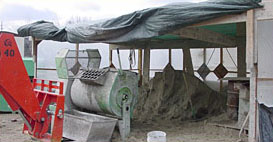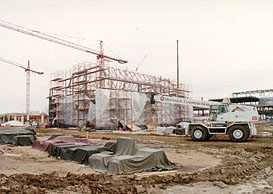Cold Weather Masonry Construction
 Two options provided for contractors under the code are protecting the mortar mixing area and heating mortar ingredients. |
This temperature is also the point when good mason contractors implement their best quality control efforts. While modern technology has extended the building season to nearly year-round in most places, the magic number hasn't changed, largely because the basic properties of mortar materials and masonry units remain relatively constant.
Masonry construction has come a long way since the 1920s, when the late Axel Ohman was setting stone on Minneapolis' first skyscraper, the Foshay Tower. Mark Peschel, now an owner of the firm Ohman founded, recalls him describing that the only way to keep the masons and the masonry from freezing was to build bonfires below the scaffolding and then hope that the rising heat would keep them warm enough. When it got too cold for that strategy, Ohman went back to Norway and waited for spring.
Fortunately, today's mason contractor doesn't have to wait for warmer weather. Season-extending techniques can be as simple as heating the mortar ingredients and storing units in a protected enclosure or as sophisticated as completely enclosing the construction area in poly-draped scaffolding, pumping in heat from propane heaters, or using specially-blended ingredients. But the goals, even after more than 75 years, are the same: keep the masons and units from freezing and keep the mortar above the magic number of 40 degrees.
Codes and Technology
Some of the techniques to protect both masons and masonry materials come from either codes or technology.
 Keeping materials off of the ground and covered is required, as shown in this picture of the staging and delivery process for this corporate headquarters built by McGough Construction Company, Inc. of St. Paul, Minn. |
For example, the code requires windbreaks with winds above 15 mph and temperatures below 25 degrees. Dan Schiffer, president of Schiffer Mason Contractors, Inc. of Holt, Mich., utilized an innovative windbreak plan when his company needed to protect its mortar-mixing area for a large project. Part of his plan involved lining up construction trailers as windbreaks on each side of the mortar mixing area, thus partially enclosing it. This allowed the space in between to serve as a virtual mortar-mixing assembly line, reducing the time from mixer to boards and aiding heat rentention of the mortar.
Technology offers other winter weather options. Today's larger LP gas heaters, with more powerful blowers, enable 24-hour heating of enclosures. To conserve as much heat as possible, some scaffold rental companies provide newer poly enclosures that fit their scaffold systems more tightly than site-adapted systems.
Miron Construction of Neenah, Wisc., uses heated enclosures with a unique heat-delivery method: a perforated fabric tube running under the scaffolding, carrying heated air from the blower down the length of the scaffold.
Another technological advancement is the fact that contractors today can access far better weather information. Many subscribe to services that provide them with up-to-the-minute weather data with the click of a mouse, while others have local weather service phone numbers on speed-dial. Either option provides information on "ambient" temperatures (e.g., right now) and "mean daily" temperatures (e.g., the average of the highest and lowest temperatures during a 24-hour period).
Tricks of the Trade
Another way to beat Old Man Winter is to utilize bulk-delivered dry mortar ingredients, which avoids the potential for uneven heating and scorching caused when trying to thaw a pile of damp sand. Using dry ingredients "is one of the best techniques developed for modern winter masonry construction," says Mike Cook, vice president of Bricklayers and Allied Craftworkers (BAC) Local 1 MN/ND and former supervisor at Gresser Concrete Masonry of Eagan, Minn.
Combining dry, unfrozen ingredients with heated water achieves a higher mortar temperature. In fact, heated water may be the most important ingredient, given water's capacity to retain heat and impart it to the other ingredients.
In addition, the heat from hydrating the cement brings a small temperature rise in the plastic mortar. While not a significant increase, given the relatively small volume and large area of mortar joints, it may be just enough when combined with other techniques to make a real difference. As the heated water begins hydrating the cement, the temperature rise is cumulative before leveling off, which provides some extra time before cooling begins.
Another option is to use Type III (quick-setting) cement, which increases available heat even further, or one of the varieties of available admixtures, which can accelerate mortar setting. Keep in mind, the design professional of record must approve the use of such admixtures since some can be damaging to the masonry or to imbedded metal. This is especially true of those containing chlorides.
Finally, instead of straw, contractors can now use insulating blankets, electric blankets or heat lamps to retain the heat of cement hydration for extended periods.
Keep Units Toasty, Not Torched
Frozen units, or those with visible ice or snow, must not be used. A frozen unit is defined as one with a measured temperature of 20 degrees or less - a unit's temperature can be accurately determined by using flat, instant-read thermometers.
Rather than leaving units out in the elements, a better solution is if units can be stored in the dry, heated scaffold enclosure. This option forgoes the need for "torching" them, which increases the risk of thermal shock and cracking.
Skilled contractors who can accurately predict the number of units needed in a given period of time know the value of moving just the right number of units from outdoor, covered storage into the building's heated enclosure for just-in-time delivery to the scaffold.
For example, when necessary, Fred Kinateder Masonry, Inc. of Waukesha, Wisc., heats the masonry units in a separate metal enclosure outside the cramped, enclosed work area and delivers them pre-warmed to the scaffold. The rented enclosure can hold up to 7,000 brick at once, and a forklift with a long reach can access the cubes from either end.
Using heated, fully dry units along with the techniques listed earlier provides for maximum heat retention.
Grouted Masonry
 Under extreme conditions, using either heated partial or complete enclosures may be the answer to assuring quality. |
After your walls start going up, it is important to keep the newly laid masonry - especially grouted masonry - from freezing until the grout has reached initial set, the units have absorbed most of the water, and the related risk of freezing is diminished.
The MSJC requirement is to keep masonry walls maintained above 32 degrees for 24 hours after completing ungrouted masonry and 48 hours for grouted masonry (unless only Type III cement is used). This protected time is required so the compressive and/or flexural bond strength of the masonry is not compromised. Also, mortar can also lose much of its compressive strength if frozen before initial set, and frozen grout can crack units. However, mortar and grout may recover somewhat if it warms up enough for the cement to hydrate.
Have a Plan Established
Planning is the key to success of any method. Code requires having a plan if construction site temperatures will fall below 40 degrees or if the temperature of the units or completed masonry waiting for grout could fall below that point. As anyone involved in masonry construction knows, unanticipated delays can change schedules significantly. In fact, even if no plan has been submitted, once the magic number is reached, the code requirements are triggered. That's when expecting the unexpected can mean the difference between a project on schedule and on budget and one that's not. (See MSJC Specification Commentary, Section 1.8, Project Conditions, page SC-7, 2002 edition.)
Modern technology has extended masonry construction through the coldest seasons, but it comes with a price. Building in cold weather is costly, given fuel, additional equipment, enclosure structures, extra planning time and other factors. Some mason contractors estimate a premium somewhere between 10-20% more than "normal" weather construction, and the well-prepared bid accordingly.
Still, all winter construction requires special treatment and techniques, and when a tight schedule is important, the masonry premium may not seem too significant. Mason contractors and crews who are experienced and prepared can minimize these costs and protect tight schedules with innovative ideas that assure the integrity of the masonry and the safety of the craftworkers.
Note: For details on the Masonry Standards Joint Committee requirements for cold weather construction, see Section 1.8 of the MSJC Code and Specification. (ACI 530-530.1/ASCE 5-6/TMS 502-602). Also, BAC/IMI contractors can brush-up on cold weather code requirements in a new class through IMI's Contractor College program. For more information, visit www.imiweb.org.
About the Author
Olene Bigelow is Minnesota director of market development and technical services for the International Masonry Institute (IMI), a strategic alliance of the International Union of Bricklayers and Allied Craftworkers and signatory contractors, with core missions of craft training and technical assistance to the design and building communities. Bigelow chairs the IMI Code Committee. She is also a past board member of The Masonry Society and chair of its Certification Committee. Her educational background includes a bachelor's from Gustavus Adolphus College and graduate work at the University of Minnesota.


















